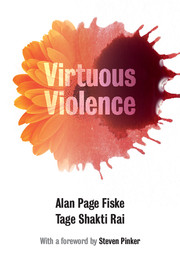Book contents
- Frontmatter
- Dedication
- Contents
- Figures and tables
- Foreword
- Warm thanks
- The point
- 1 Why are people violent?
- 2 Violence is morally motivated to regulate social relationships
- 3 Defense, punishment, and vengeance
- 4 The right and obligation of parents, police, kings, and gods to violently enforce their authority
- 5 Contests of violence: fighting for respect and solidarity
- 6 Honor and shame
- 7 War
- 8 Violence to obey, honor, and connect with the gods
- 9 On relational morality: what are its boundaries, what guides it, and how is it computed?
- 10 The prevailing wisdom
- 11 Intimate partner violence
- 12 Rape
- 13 Making them one with us: initiation, clitoridectomy, infibulation, circumcision, and castration
- 14 Torture
- 15 Homicide: he had it coming
- 16 Ethnic violence and genocide
- Chapter 17 Self-harm and suicide
- 18 Violent bereavement
- 19 Non-bodily violence: robbery
- 20 The specific form of violence for constituting each relational model
- 21 Why do people use violence to constitute their social relationships, rather than using some other medium?
- 22 Metarelational models that inhibit or provide alternatives to violence
- 23 How do we end violence?
- 24 Evolutionary, philosophical, legal, psychological, and research implications
- The dénouement
- References
- Index
5 - Contests of violence: fighting for respect and solidarity
Published online by Cambridge University Press: 05 December 2014
- Frontmatter
- Dedication
- Contents
- Figures and tables
- Foreword
- Warm thanks
- The point
- 1 Why are people violent?
- 2 Violence is morally motivated to regulate social relationships
- 3 Defense, punishment, and vengeance
- 4 The right and obligation of parents, police, kings, and gods to violently enforce their authority
- 5 Contests of violence: fighting for respect and solidarity
- 6 Honor and shame
- 7 War
- 8 Violence to obey, honor, and connect with the gods
- 9 On relational morality: what are its boundaries, what guides it, and how is it computed?
- 10 The prevailing wisdom
- 11 Intimate partner violence
- 12 Rape
- 13 Making them one with us: initiation, clitoridectomy, infibulation, circumcision, and castration
- 14 Torture
- 15 Homicide: he had it coming
- 16 Ethnic violence and genocide
- Chapter 17 Self-harm and suicide
- 18 Violent bereavement
- 19 Non-bodily violence: robbery
- 20 The specific form of violence for constituting each relational model
- 21 Why do people use violence to constitute their social relationships, rather than using some other medium?
- 22 Metarelational models that inhibit or provide alternatives to violence
- 23 How do we end violence?
- 24 Evolutionary, philosophical, legal, psychological, and research implications
- The dénouement
- References
- Index
Summary
Neither boy spoke. If one moved, the other moved – but only sidewise, in a circle; they kept face to face and eye to eye all the time. Finally Tom said:
“I can lick you!”
“I’d like to see you try it.”
“Well, I can do it.”
“No you can’t, either.”
“Yes I can.”
“No you can’t.”
“I can.”
“You can’t.”
“Can!”
“Can’t!” … .
“Well, you said you’d do it – why don’t you do it?”
“By jingo! for two cents I will do it.”
The new boy took two broad coppers out of his pocket and held them out with derision. Tom struck them to the ground. In an instant both boys were rolling and tumbling in the dirt, gripped together like cats; and for the space of a minute they tugged and tore at each other’s hair and clothes, punched and scratched each other’s nose, and covered themselves with dust and glory. Presently the confusion took form, and through the fog of battle Tom appeared, seated astride the new boy, and pounding him with his fists. “Holler ’nuff!” said he.
The boy only struggled to free himself. He was crying – mainly from rage.
“Holler ’nuff!” – and the pounding went on.
At last the stranger got out a smothered “’Nuff!” and Tom let him up and said:
“Now that’ll learn you. Better look out who you’re fooling with next time.”
Mark Twain, The Adventures of Tom SawyerA number of widespread practices consist of culturally organized violence: the relationship between the participants consists of violent acts directed at each other. The violence itself is typically regulated by EM, while the result created is AR of victors over vanquished. The first-person relationship constituted by the violence also extends to the participants’ relationships with second persons such as fans and admirers, as well as these second persons’ relationships with third parties, such as supporters of the opponent. That is, the allies, teammates, family, coaches, peers, or fans of the combatants are communally identified with them, so that the combatant’s victory is shared by them all.
- Type
- Chapter
- Information
- Virtuous ViolenceHurting and Killing to Create, Sustain, End, and Honor Social Relationships, pp. 60 - 76Publisher: Cambridge University PressPrint publication year: 2014

